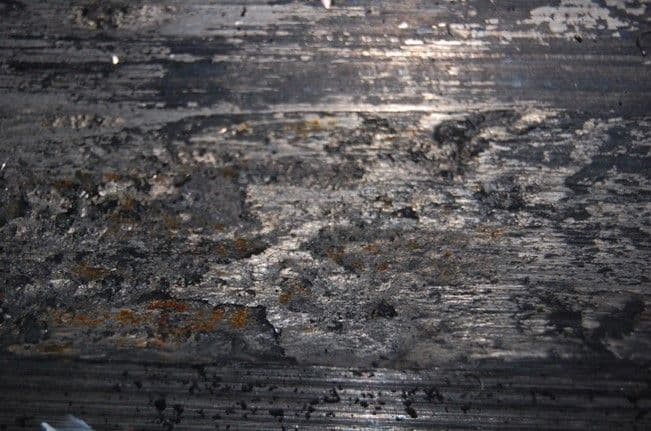Description
Adhesion wear is a damage mechanism that occurs between two surfaces in contact and in relative motion, and may be considered to be a severe form of abrasive wear, often leading to galling, although each of these three phenomena may occur exclusively.
Abrasive wear may be considered as surface degradation due to the impact from or contact with another surface or particle leading to the detachment of small particles of material.
Galling may be considered as an extreme form of adhesive wear involving high friction, solid-phase welding, and material flow.
Mechanism
Regardless of how finely polished a surface may be there will always be undulations, or peaks and troughs that remain. Therefore, when two surfaces are placed in contact, and particularly when under high loading, the loads are taken through small points of contact, or asperities. Under particularly high loads, the induced contact stress at the asperities may cause atomic bonds to be formed to the point where the bond can be considered as a solid-phase weld, causing adhesion.
Relative movement of the two surfaces will cause any bonded asperities to plastically deform and then fracture due to the applied shear stress. As motion continues, other asperities will then make contact, going through the cycle of deformation, bonding, and fracture, with the added potential for small particles of material to break off the surfaces which can then act as an abrasive, contributing to surface degradation as abrasive wear.
With severe adhesion and abrasion, the extent of surface degradation can quickly increase leading to plastic deformation and smearing of material, termed as galling.
With lower loads or contact stresses, adhesion may not occur although fracture of the asperities leading to the presence of particulates at the sliding interface, will increase the probability for the subsequent initiation of adhesion, abrasion, and galling.
It is understood that adhesive wear is promoted by two major factors1. The first of these relates to the tendency for different materials to form solid solutions or intermetallic compounds with one another. Combinations of materials with different crystal structures and chemical properties tend to have lower adhesion and this may result in lower wear rate and friction.
The second factor relates to the cleanliness of the surface with cleaner surfaces being more likely to bond together. The cleanliness of the surfaces also considers the presence of oxide films with surfaces having a thick and adherent oxide film tending to exhibit lower wear. Alloys with thin oxide films, such as stainless steels and nickel alloys, exhibit poor adhesive wear resistance.
Appearance and Examples
A surface which has been subjected to adhesive wear may exhibit a range of damage, depending on the severity of the adhesion. The image below shows the sidewall of a punch used in a forging process that suffered from severe adhesive wear resulting in scoring and galled material.

Microexamination of a section through the surface reveals the highly deformed galled material and deformation of the parent material as shown below.

Another example is of a shaft used in a gearbox assembly that had fractured in service due to a fatigue crack which had propagated through the shaft, close to the end-face of a nut. On examination, the threads on the shaft were found to be of good form with no evidence of damage. The nut was seized on the shaft threads and on sectioning the shaft through the nut, the threads contained within the location of the nut were observed to be severely galled as shown below.

Given that the threads on the shaft, external to the nut end faces were intact, this showed that some form of adhesion and galling had occurred within a short distance of nut travel along the shaft. The nut should have been tightened to a specified torque to set a preload in the shaft. However, the level of galling would have significantly reduced this preload as some of the effort in torque loading would have been used to overcome the friction produced by the adhesion and galling. As a consequence of the reduced preload, the shaft was subjected to increased cyclic stress amplitudes which subsequently led to fatigue failure.
